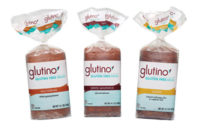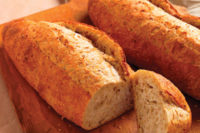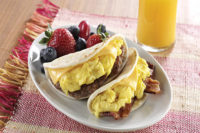Our 2013 State of the Industry report explores market information for the bread aisle, sweet goods, cookies, bars, snack cakes, frozen baked goods, tortillas, pies and more.
It’s been a slippery road this year. Impacted by a widespread drought, fluctuating commodity prices and a still-weak economy, bakers have been hit with some tough circumstances. Many bakery products have put on the brakes in sales. But certain segments are accelerating, and overall, the bakery market is in the driver’s seat in terms of bakers’ response to consumer and customer needs, wants and wishes.
Many factors have affected the bakery market over the last year. Commodity prices—and this is a big one—swerved, drove uphill and stayed there. GE Capital’s Spring 2013 report mentions that key commodity prices rose 10-20% by February 2013 versus the summer of 2012, and some signs of weakness have re-emerged. However, GE Capital says its base case expectations are for commodity prices to remain relatively stable most of this year, with a modest upward bias heading into 2014, assuming global economic activity picks up as expected. This reflects a continued deceleration in global economic growth and a weak U.S. dollar.
Customers are ordering ingredients on much tighter budgets in an attempt to further control costs. Even large companies like Kellogg Co., Battle Creek, Mich., and Hillshire Brands, Chicago, reported slimmer than anticipated quarterly sales, as budget-conscious consumers cut back on desserts, sending its shares lower. Hillshire, which owns Sara Lee frozen cakes, reported a better-than-expected profit and says its 2013 earnings will be at the high end of its forecast.
Kellogg’s sales rose to $3.86 billion in the first quarter of 2013, but the company says its net income was $311 million, down from $351 million a year ago. This decline was largely due to the rising cost of commodities, Kellogg reports, adding that the first quarter of 2013 included most of the inflation it expects for the full year. According to Reuters reports, Kellogg chief executive John Bryant recently stated the one business that was softer than he would like is cookies, where consumption fell 5.5% in the quarter.
For Hillshire, sales in its foodservice business declined due to weakness in frozen bakery products. “Consumers continued their retreat from desserts amidst challenged household budgets,” states Sean Connolly, Hillshire CEO.
And slow sales of cookies and sweets at Mondelez International, Deerfield, Ill., seems to indicate that they are more popular around the world right now than in the U.S., according to early May online reports in The Wall Street Journal and on Nasdaq.com. The company reported that 2013 first-quarter profits fell 30%, due to impacts from its separation last year from Kraft Foods Group Inc., Northfield, Ill. Reports indicate the company posted organic sales growth of 3.8%, below the anticipated 5-7% long-term growth rate.
And while it’s starting up again under different ownership, Hostess Brands LLC, now based in Dallas, created a temporary vacuum with its exit from the market.
Drought conditions that devastated parts of the Midwest last summer still persist, though recent rains have improved some planting conditions. Current market expectations are for strong spring plantings and higher yielding crops this fall, increasing corn supplies. Corn prices jumped dramatically, starting in 2010, and remain at elevated levels, due to the impact of adverse weather conditions on crop yields and strong global demand. As of early May, the U.S. Department of Agriculture’s (USDA) average farm corn price forecast for 2012/13 was $7.10 per bushel, up from $6.22 the prior year. And corn futures were currently trading lower, as of presstime.
Also as of presstime, wheat prices were rising, due to strong demand and tightening global supplies. The USDA’s March average wheat farm price for 2012/13 was forecast at $7.80 per bushel. Prices for 2011/12 and 2010/11 were $7.24 and $5.70, respectively.
Mint condition
Despite these cost drivers, high-quality ingredients are always in great demand. Consumers also expect more sophisticated tastes, exciting ingredients and different textures, explains Erin Lifeso, senior director of marketing at Balance Bar, Ronkonkoma, N.Y. “Also, gluten-free products continue to be in high demand and serve the population with special dietary needs,” she adds.
“Wholesome [treats] not only have to taste great, but they must be made with things people can feel good about,” says Matt Duffy, director of marketing for Nonni’s Foods, LLC, Oakbrook Terrace, Ill. “Consumers are reading product labels more closely, and we are seeing the effects of a simple food movement when it comes to ingredients.”
Thus, bakers are improving the nutrition of their products by cutting sodium, sugar, trans-fat and calories; eliminating genetically modified organisms (GMOs); and adding whole grains, fiber and calcium. Healthier breads offer the largest opportunity for growth in the bread aisle, affirms Lawrence Marcucci, president of Alpha Baking Co., Chicago. “People continue to educate themselves about the effects and benefits of the foods that they eat, and bread manufacturers need to meet (if not exceed) consumer desires for healthy products that taste great,” he says.
Natural, gluten-free products are a big part of the bar segment, and fiber is becoming a key secondary driver, reports Kellogg Snacks, Battle Creek, Mich. “Our most recent innovations offer more nutrient options,” says Mary Busch, director of brand marketing. “For example, many people are seeking positive nutrition from their snacks, particularly protein and fiber. To satisfy this need, Kellogg debuts FiberPlus Antioxidant Protein Chewy bars, available in Mixed Nut and Peanut.”
Bakers in the bread/buns/rolls, sweet goods and cookie categories say their segments will need to continue evolving with consumer demand. “We will continue seeing the traditional cookie segment grow stronger with the increase of organic and clean ingredients, and more whole-food or superfood cookies will appear,” says Robert Dalson, national sales manager at Torn Ranch, Petaluma, Calif. “This will morph into making cookies healthier and, at some point, include supplements, [like vitamins].”
Whether as a response to the obesity issue or legislative issues, the cookie market in general is witnessing manufacturers cleaning up their labels, affirms Joanne Adirim, CEO of Gardena, Calif.-based HannahMax Baking. “We’re seeing cleaner, simpler ingredients, because consumers are demanding better quality and are more conscientious in what they’re eating.”
Brad Sterl, founder and president of Rustic Crust, Pittsfield, N.H., agrees. “Consumers are looking for a clean label and an ingredient list they can understand and feel good about. Healthier options are at the top of the list, while new and inspiring flavors top the charts as well.”
Artisan aerodynamics
Artisanal breads such as crusty baguettes and hand-made focaccias, continue to remain on-trend, says Felix Barats, owner of Chicago Specialty Bakers, a Bensenville, Ill., baker that specializes in old-world recipes and fresh ethnic breads and rolls made with “top-shelf ingredients.” Barats says his customers look at the cost of the product first, but will pay more for the specialty breads. “They don’t mind so much if they’re buying a better-quality product,” he says. “Customers are looking for more artisan-style products, which is our specialty.”
Handling both small custom and high-volume specialty orders with equal excellence, the bakery is expanding into specialty supermarket and grocery store chains, as well as into the airline business. “We get requests for more bold flavors and breads in different shapes and sizes,” Barats adds. “Now, customers want more custom-style, natural products without preservatives. In the last year, we introduced a variety of German-style pretzel products; real Italian Ciabatta with an open cell structure; hand-made focaccia with toppings; and traditional levain-based, dark, Russian and European rye breads. The Russian rye is our version of the ‘Borodinsky,’ which we hope will become the next big thing in the U.S. since the Italian Ciabatta.”
Production of such artisan breads and other items is being automated more frequently. Barats says Chicago Specialty has a custom-designed artisan production line that took four years to design and build to its specifications. “The line handles dough as gently as if it were handled by hand,” he explains.
Rustic Crust introduced a Ciabatta bread in September 2012 that has the look and quality of hand-made versions and features all nonGMO ingredients and no chemicals or preservatives. “Consumers are very price-conscious today, but are looking for better products and items they feel are a bit healthier,” Sterl says. “Our of all natural products are seeing very nice growth.”
Allergen factors
Allergen-free products first seemed like they had a rolling start, but are picking up speed. Allergen-free cookie maker Fancypants Baking, East Walpole, Mass., sees good sales growth from its allergen-friendly products. “The push toward nut-free offerings has definitely increased, due to greater publicity and the fact that school districts across the country are beginning to ban food products that may contain nuts,” says Justin Housman, founding partner.
And as stated earlier, the gluten-free products in this part of the market are racing ahead. “Overall, the gluten-free market has exploded in the past few years to become a $4.2-billion industry,” says Pamela Giusto-Sorrells, president and founder of Pamela’s Products, Ukiah, Calif. “More than ever, consumers seek convenience and great taste in the gluten-free category, [and] Pamela’s on-the-go Whenever Bars satisfy the need for delicious options right off the shelf. Gluten-free foods often get pinned as lacking in taste and texture, but we found that consumers prefer gluten-free treats that everyone in the family can enjoy, whether living with gluten allergies or not.”
With gluten-free products, the trend is to produce bread that looks and tastes like “regular” bread, echoes Jerry Bigam, CEO of Kinnikinnick Foods Inc., an Edmonton, Alb., manufacturer of gluten-free baked goods, bakery products and mixes that have the texture of regular wheat-based products. “More attention is being focused on nutritious products with higher fiber and lower sugar and sodium, along with the levels of enrichment that are found in conventional breads,” he says. “The same applies to buns. The other trend in gluten-free is that product lines are expanding to include buns, submarine rolls and other special varieties of existing formulas (e.g. multigrain hamburger buns).”
Like traditional products, the gluten-free versions are improving in quality and the demand for basic breads and buns remains strong, Bigam continues. “Since the quality of products has improved so much, there are many new customers who consider gluten-free as just another specialty bread,” he adds.
Demand for sweet goods is strong, but the growth has flattened out due to economic conditions, Bigam says. “Gluten-free products will continue to expand in scope and become a constant standard in the bread and bun business as more and more consumers find the products’ health and diet benefits,” he says. “Medical evidence supports the view that gluten-free products can improve the health of a significant number of consumers.”
Kinnikinnick’s success with its new “Soft” breads and buns has led to the introduction of “Soft” bagels. Additional items will be introduced later this year, Bigam says. All seven of the new “Soft” bread and bun items feature new packaging.
“The biggest issue in the gluten-free area and private-label products is food safety and the danger of cross contamination in copacking plants,” Bigam adds. “The new food-safety regulations will make this an even more demanding situation. Branded products continue to expand in the market, which makes it even more difficult to generate the cost savings usually associated with private-label items.”
Convenient pitstops
“More Americans live hectic lifestyles, which will lead to higher-frequency snacking to accommodate time restraints for traditional meals,” says Nonni’s Foods’ Duffy. “On the other hand, a recovering economy would increase spending and consumption. This is where health and convenience trends will draw attention and increase demand.”
Perhaps that’s why nearly half the sandwiches consumed in 2012 were bought at restaurants instead of being made at home, according to data released by Technomic Inc. Sandwich stores like Subway have capitalized on this for a while, while others like Jimmy John’s Gourmet Sandwiches, Jason’s Deli, Firehouse Subs and Jersey Mike’s Subs are hitting the gas in this submarine sandwich shakedown, which Techomic values at $27.7 billion.
And speaking of sandwiches, the use pretzel bread in sandwiches is widespread. Pretzel bread has quickly become one of the fastest-growing food trends in the U.S., mainly because of Americans’ cravings for nostalgic comfort foods. Dataessential, the restaurant data-tracking service, says pretzel bread is the fastest-growing sandwich bread, with a 36% increase on sandwich menus from 2011 to 2012.
Ethnic and specialty breads such as naan, flatbread and similar Mediterranean styles that can be used in nontraditional ways are breezing past the competition in the Popularity 500, Sterl adds.
Michael Angelo’s Gourmet Foods, Austin, Texas, launched a new line of Italian flatbread recently, which represents its first foray into meal occasions other than center-of-the plate entrees. The company launched four flatbread varieties including Pepperoni & Salami, Mediterranean flatbread, Sausage & Mushroom and Margherita.
“Fewer people are eating three square meals a day, and in response, we have adapted our line of Italian foods to give options that fit a snacking lifestyle,” says Michael Angelo’s founder and CEO Michael Angelo Renna.
Photo finish
So by far, bakers are faced with keeping quality and productivity up, while keeping costs down. “And, of course, meeting the diverse needs of small and large customers is tricky,” Barats adds.
The good news is that consumer confidence in the economy is edging upward, according to a Nielsen global survey conducted in February/March of this year, and spending intentions in North America are rising. The iffy news? Consumers are still stressed from economic issues and watching what they spend. But bakers are heeding the calls of consumer and customer demands, watching their bottom lines and obviously paying top attention to food safety in their operations. New market twists and turns await us all in the industry, but the finish line to success may just be closer than we think.


















